- Clone
- GoH3 (See other available formats)
- Regulatory Status
- RUO
- Workshop
- HCDM listed
- Other Names
- VLA-6 α chain, α6 integrin, integrin α6, ITGA6
- Isotype
- Rat IgG2a, κ
- Barcode Sequence
- TTCCGAGGATGATCT
- Ave. Rating
- Submit a Review
- Product Citations
- publications
CD49f is a 120 kD integrin family member also known as VLA-6 α chain and α6 integrin subunit. CD49f associates with either integrin β1 (CD29) or integrin β4 (CD104) to form receptors (VLA-6 or α6β4 complex) for laminin and kalinin. CD49f is expressed on platelets, monocytes, T cells, placental trophoblasts, and epithelial and endothelial cells. CD49f is involved in adhesion and can act as a co-stimulatory molecule for T cell activation and proliferation.
Product DetailsProduct Details
- Verified Reactivity
- Human, Mouse, Cynomolgus, Rhesus
- Reported Reactivity
- African Green, Baboon, Capuchin Monkey, Cat, Cow, Chimpanzee, Cynomolgus, Dog, Horse, Rabbit, Sheep, Pig
- Antibody Type
- Monoclonal
- Host Species
- Rat
- Immunogen
- Mouse mammary tumor cells
- Formulation
- Phosphate-buffered solution, pH 7.2, containing 0.09% sodium azide and EDTA
- Preparation
- The antibody was purified by chromatography and conjugated with TotalSeq™-D oligomer under optimal conditions.
- Concentration
- 0.5 mg/mL
- Storage & Handling
- The antibody solution should be stored undiluted between 2°C and 8°C. Do not freeze.
- Application
-
PG – Quality tested
- Recommended Usage
-
Each lot of this antibody is quality control tested by immunofluorescent staining with flow cytometric analysis and the oligomer sequence is confirmed by sequencing. TotalSeq™-D antibodies are compatible with Mission Bio’s Tapestri Single-Cell Sequencing Platform for simultaneous detection of DNA and Protein.
To maximize performance, it is strongly recommended that the reagent be titrated for each application, and that you centrifuge the antibody dilution before adding to the cells at 14,000xg at 2 - 8°C for 10 minutes. Carefully pipette out the liquid avoiding the bottom of the tube and add to the cell suspension. For Proteogenomics analysis, the suggested starting amount of this reagent for titration is ≤ 1.0 µg per million cells in 100 µL volume. Refer to the corresponding TotalSeq™ protocol for specific staining instructions.
Buyer is solely responsible for determining whether Buyer has all intellectual property rights that are necessary for Buyer's intended uses of the BioLegend TotalSeq™ products. For example, for any technology platform Buyer uses with TotalSeq™, it is Buyer's sole responsibility to determine whether it has all necessary third party intellectual property rights to use that platform and TotalSeq™ with that platform. - Application Notes
-
Additional reported applications (for the relevant formats) include: immunoprecipitation1,5, in vitro and in vivo blocking of cell binding to laminin and blocking the function of integrin a61,4, and immunohistochemistry of acetone-fixed frozen sections2,3,5. The GoH3 antibody has been reported to block laminin binding in vitro and to block integrin a6 function in vivo.
- Additional Product Notes
-
TotalSeq™-D reagents are designed to profile protein expression at single cell level. The Mission Bio Tapestri platform and sequencer (e.g. Illumina analyzers) are required. Please contact technical support for more information, or visit biolegend.com/totalseq/single-cell-dna
The barcode flanking sequences are CGAGATGACTACGCTACTCATGG (PCR handle), and GAGCCGATCTAGTATCTCAGT*C*G (capture sequence). * indicates a phosphorothioated bond, to prevent nuclease degradation.
View more applications data for this product in our Application Technical Notes. -
Application References
(PubMed link indicates BioLegend citation) -
- Georas SN, et al. 1993. Blood 82:2872. (IP, Block)
- Honda T, et al. 1995. J. Clin. Endocrinol. Metab. 80:2899. (IHC)
- Sonnenberg A, et al. 1986. J. Histochem. Cytochem. 34:1037. (IHC)
- Nakamura K, et al. 1997 Biochem. Biophys. Res. Commun. 235:524. (Block)
- Sonnenberg A, et al. 1987 J. Biol. Chem. 262:10376. (IP, IHC)
- Deregibus MC, et al. 2007. Blood doi:10.1182/blood-2007-03-078709.
- Horwitz KB, et al. 2008. Proc Natl Acad Sci USA. 105:5774. PubMed
- Nardella C, et al. 2009. Sci Signal. 2:55. PubMed
- Xu T, et al. 2010. Mol Cancer Ther. 9:438. PubMed
- Stepp MA, et al. 2007. J Cell Sci. 120:2851. PubMed
- Jo M, et al. 2010. Cancer Res. 70:8948. PubMed
- Yoshino N, et al. 2000. Exp. Anim. (Tokyo) 49:97. (FC)
- Grange C, et al. 2011. Cancer Res. 71:5346. PubMed
- Lai KP, et al. 2012. Mol Endocrinol. 26:52. PubMed
- Oeztuerk-Winder F, et al. 2012. EMBO J. 31:3431. (FC) PubMed
- Product Citations
-
- RRID
-
AB_2904341 (BioLegend Cat. No. 313641)
Antigen Details
- Structure
- Integrin family, associates with β1 or β4, 120 kD
- Distribution
-
Platelets, monocytes, T cells, placental trophoblasts, epithelial and endothelial cells
- Function
- Adhesion, receptor for laminin and kalinin; laminin binding to VLA-6 induces T cell co-stimulation for proliferation and activation
- Ligand/Receptor
- With integrin β1 (CD29) forms VLA-6, with integrin β4 (CD104) forms a6β4 integrin; laminin and kalinin are ligands for these receptors
- Cell Type
- Embryonic Stem Cells, Endothelial cells, Epithelial cells, Monocytes, Platelets, T cells
- Biology Area
- Cell Adhesion, Cell Biology, Immunology, Innate Immunity, Stem Cells
- Molecular Family
- Adhesion Molecules, CD Molecules
- Antigen References
-
1. Sonnenberg A, et al. 1990. J. Cell Biol. 110:2145.
2. Sonnenberg A, et al. 1990. J. Cell. Sci. 96:207.
3. Aumailley M, et al. 1990. Exp. Cell Res. 188:55.
4. Niessen CM, et al. 1994. Exp. Cell Res. 211:360. - Gene ID
- 16403 View all products for this Gene ID 3655 View all products for this Gene ID
- UniProt
- View information about CD49f on UniProt.org
Related FAQs
Other Formats
View All CD49f Reagents Request Custom ConjugationCompare Data Across All Formats
This data display is provided for general comparisons between formats.
Your actual data may vary due to variations in samples, target cells, instruments and their settings, staining conditions, and other factors.
If you need assistance with selecting the best format contact our expert technical support team.
-
Purified anti-human/mouse CD49f
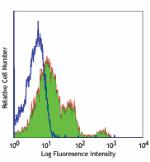
Human peripheral blood lymphocytes stained with purified GoH... 
MDA-MB-231 breast cancer cells were stained with anti-CD49f ... -
Biotin anti-human/mouse CD49f
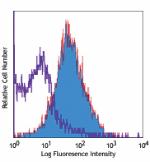
C57BL/6 mouse splenocytes stained with biotinylated GoH3, fo... -
FITC anti-human/mouse CD49f

Human peripheral blood lymphocytes stained with GoH3 FITC -
Alexa Fluor® 488 anti-human/mouse CD49f
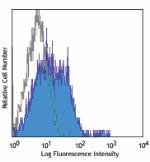
Human peripheral blood lymphocytes were stained with anti-hu... -
Alexa Fluor® 647 anti-human/mouse CD49f

Human peripheral blood lymphocytes stained with GoH3 Alexa F... -
PE anti-human/mouse CD49f
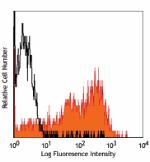
Human peripheral blood lymphocytes stained with GoH3 PE -
APC anti-human/mouse CD49f
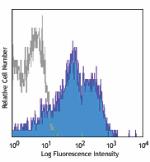
Human peripheral blood lymphocytes were stained with anti-hu... -
PerCP/Cyanine5.5 anti-human/mouse CD49f

Human peripheral blood lymphocytes stained with GoH3 PerCP/C... -
Pacific Blue™ anti-human/mouse CD49f
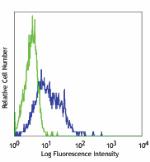
Human peripheral blood lymphocytes stained with GoH3 Pacific... -
PE/Cyanine7 anti-human/mouse CD49f
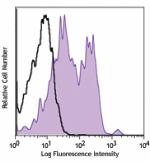
Human peripheral blood lymphocytes were stained with anti-hu... -
Brilliant Violet 421™ anti-human/mouse CD49f

Human peripheral blood lymphocytes were stained with anti-hu... 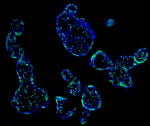
Human paraffin-embedded placenta tissue slices were prepared... -
PE/Dazzle™ 594 anti-human/mouse CD49f
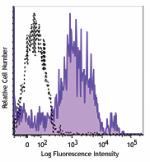
Human peripheral blood lymphocytes were stained with anti-hu... -
APC/Cyanine7 anti-human/mouse CD49f
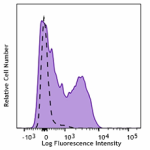
Human peripheral blood lymphocytes were stained with CD49f (... -
APC/Fire™ 750 anti-human/mouse CD49f

Human peripheral blood lymphocytes were stained with anti-hu... -
TotalSeq™-A0070 anti-human/mouse CD49f
-
TotalSeq™-C0070 anti-human/mouse CD49f
-
Ultra-LEAF™ Purified anti-human/mouse CD49f

Human peripheral blood lymphocytes stained with purified GoH... 
MDA-MB-231 breast cancer cells were stained with anti-CD49f ... -
TotalSeq™-B0070 anti-human/mouse CD49f
-
TotalSeq™-D0070 anti-human/mouse CD49f
-
Brilliant Violet 510™ anti-human/mouse CD49f

Human peripheral blood lymphocytes were stained with anti-hu... 
Human peripheral blood lymphocytes were stained with anti-hu... -
Spark Blue™ 550 anti-human/mouse CD49f (Flexi-Fluor™)
-
Spark Blue™ 574 anti-human/mouse CD49f (Flexi-Fluor™) Antibody
-
Spark Red™ 718 anti-human/mouse CD49f (Flexi-Fluor™)















Follow Us